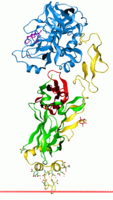
Photo from wikipedia
The year 1992 was momentous for individuals affected by hemophilia. Eight years after the successful cloning of the factor VIII gene and 5 years after clinical trials assessing the safety… Click to show full abstract
The year 1992 was momentous for individuals affected by hemophilia. Eight years after the successful cloning of the factor VIII gene and 5 years after clinical trials assessing the safety and efficacy of recombinant factor VIII concentrates commenced, Food and Drug Administration approval was granted to recombinant factor VIII concentrates.1,2 The cloning of factor IX, first reported in 1982, resulted in a licensed recombinant factor IX concentrate in 1997.3 The development of these medications was driven by the scourge of HIV and hepatitis C virus (HCV) infection of the plasma-derived factor concentrates in the 1970s and 1980s.4 The year 1992 was also momentous for me as I first participated in the care of children with hemophilia. Working with Diana Beardsley at the Hemophilia Treatment Center at Yale University, I learned the physiology of hemostasis and thrombosis as well as the true human cost of hemophilia, not only on the affected children but also on their parents and family members as they watched their children live in pain during bleeding episodes and grieved as many succumbed to HIV infection. It was during this formative period of my training when I pledged my professional life to ensuring the safe and effective care for all those affected by bleeding disorders. Fast forward 28 years. The hemophilia community is in the midst of a therapeutic transformation as stunning as the development of recombinant factor concentrates. Extended half-life factor concentrates, with their ability to target higher trough levels, are making significant inroads. Emicizumab, a factor VIII mimetic, has been Food and Drug Administration-approved for use in people of all ages with hemophilia A with or without FVIII inhibitors.5-7 Multiple medications inhibiting hemostatic inhibitors are in late-phase clinical trials.8 Gene therapy vectors have been shown to increase endogenous factor levels, with one factor IX vector demonstrating durability for over 8 years.9 With these advances in the available treatment options for people with hemophilia, our commitment to ensuring the safety and effectiveness of these new therapeutic modalities must redouble. That is why the series of papers in this month's issue of JTH are so interesting and important. Written by a consortium of the most respected and published investigators in our field (with all three manuscripts supported by Roche/Genentech, the manufacturer of emicizumab) we are walked through: (a) a review of contemporary data describing mortality for people with congenital hemophilia;10 (b) a proposal for more thoroughly assessing the cause of death in people with congenital hemophilia;11 and (c) an analysis of the Roche Emicizumab Global Safety Database using the proposed mortality assessment framework.12 I suspect one driver behind the production of these manuscripts is the recent focus on individuals who had received emicizumab and died, both in medical literature as well as in the lay press.13,14 In an attempt to provide “balanced, peer-reviewed, and scientifically rigorous clinical information about emicizumab-kxwh,” Roche had set up a website, www.emici zumab info.global, containing a curated collection of publications and scientific presentations, guidelines and recommendations, and medical resource links (including a link to the US Food and Drug Administration's searchable Adverse Event Reporting System (FAERS) database).15 Of note, the quarterly updates on thrombotic microangiopathy, serious thrombotic events, and reported fatalities previously available on this website were last
Journal Title: Journal of Thrombosis and Haemostasis
Year Published: 2021
Link to full text (if available)
Share on Social Media: Sign Up to like & get
recommendations!